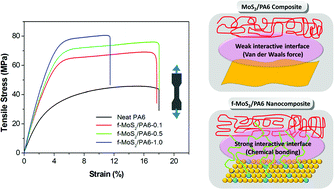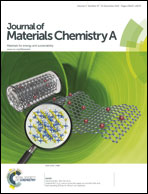An in situ polymerization approach for functionalized MoS2/nylon-6 nanocomposites with enhanced mechanical properties and thermal stability†
Abstract
The enhancement in the thermal and mechanical properties of polymer/inorganic nanosheet composites depends strongly on their interfacial interaction. Herein, we exfoliated bulk MoS2 into nanosheets which was subsequently functionalized using lipoic acid. Nylon-6 (PA6) nanocomposites were prepared through in situ ring-opening polymerization of ε-caprolactam initiated by lipoic acid functionalized MoS2 (f-MoS2). MoS2/PA6 composites were prepared by melt blending of pristine MoS2 powder with PA6 in parallel with f-MoS2/PA6 composites. The morphology of MoS2/PA6 and f-MoS2/PA6 composites observed using scanning electron microscopy and transmission electron microscopy demonstrated that f-MoS2 exhibited a better dispersion state than pristine MoS2 within a PA6 matrix. The incorporation of f-MoS2 induced significant thermal stabilization in the PA6 matrix: with 1 wt% loading of f-MoS2, the T−5% and T−50% of the resultant PA6 nanocomposite were increased by 36 and 23 °C, respectively, relative to those of neat PA6. As demonstrated by the increase in the storage modulus and the glass transition temperature determined from dynamic mechanical analysis, f-MoS2 was more effective than MoS2 in terms of reinforcing mechanical properties of PA6. At very low fractions of f-MoS2 nanosheets (≤1% by weight), PA6 nanocomposites exhibited up to 80% improvement in tensile properties compared to neat PA6 because of strong covalent polymer–filler interfacial interactions. These findings corresponded well with the nanoconfinement effect including a nanoscale interfacial layer that can support the superior reinforcements of f-MoS2 over pristine MoS2. The in situ polymerization approach proposed herein will open a new and exciting avenue for the development of transition metal dichalcogenide reinforced polymer nanocomposites.


 Please wait while we load your content...
Please wait while we load your content...